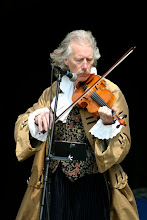A couple of years ago I built a harp for a friend who had injured her shoulder. I designed it so that she doesn't have to rest it on her shoulder and the strings are easier to to reach.
Mary loves her harp and it was traumatic when she accidentally knocked it over and broke the pillar.

With about 800 pounds of tension pulling down on the pillar it didn't stand a chance when it hit the floor - hard enough to bend the steel tuning pin!
April 9 First I had to disassemble the neck/pillar from the body. There are a couple of bolts Waaaay up top on the inside. When I had kids with small hands around they would do stuff like this for me. Luckily my arm is long enough to reach (with a socket extension) through the bottom of the harp. Next I replaced all the splinters I could find and tacked them with thin superglue. A couple of brads were driven into one side, nipped off, and pressed into the other side. This indexes the break and guards against slippage during glue-up. Next a visit to the
Carpenter's Boatshop where they had more soft jawed clamps, a good vise, and fresh WEST epoxy.
Apr 12-13 A couple of days have passed while we were gone to the
Ulster-Scots in Maine symposium. I decided that I wanted to reinforce the break, but want the repair to be as inconspicuous as possible. So I made a couple of cherry patches (we called these "Dutchmen" in the shipyard), then used the router to make a template for the cavity - one on each side. It sound easy, but I had to make an intermediate template to get the sizes to match.

The grain of the patches crosses the grain of the pillar at an angle, so there will be a good strengthening effect.

So far, so good. You can see the dark glue line in the bottom of the recess. I don't like thick glue lines like this. It is a consequence of the fracture. There were splinters that kept the joint from closing perfectly, so the reinforcements are, indeed, necessary.

I added a little bit of carbon fiber cloth to REALLY make it strong. The glue pot in the back is for quality assurance. I won't move the harp or remove the clamps until the glue in the pot cures.

Add some more WEST epoxy and clamp. (The vinegar in the background is for cleanup. It will easily wipe off epoxy while it is still uncured) Wax paper keeps the clamps from gluing down to the patches.

I should be able to take off the clamps, clean up, stain and finish on Wednesday. I have to get this harp back together and deliver it to Mary on our way to a harp workshop and concert for the
Northern Harpsong organization in Houlton on Saturday.
The Daffodils Are Out!
Here is a shot of the back garden. The front is also spectacular. Julia worked in her garden today and found some carrots from last year.
Three ticks found her. Maybe we need some chickens.























